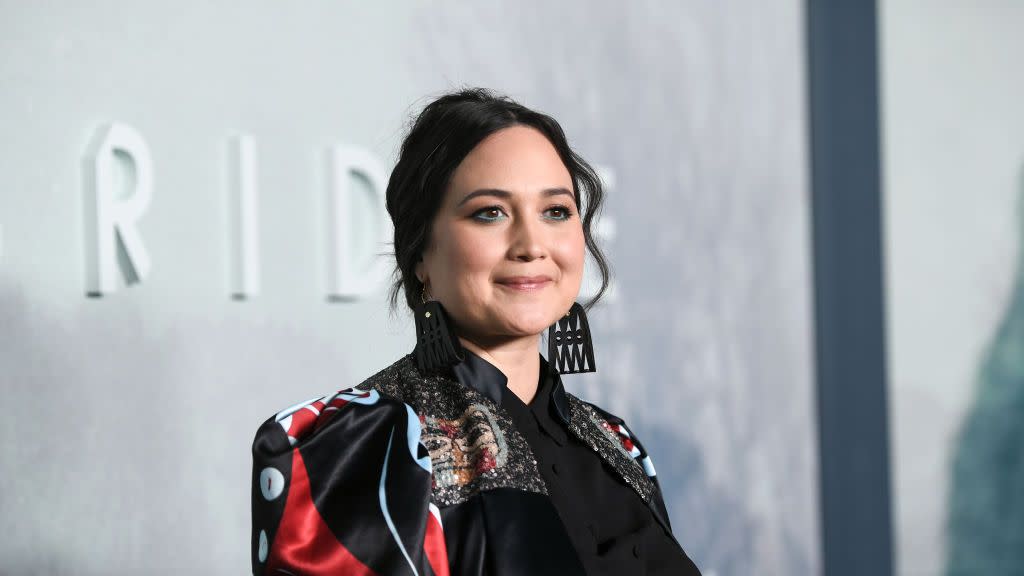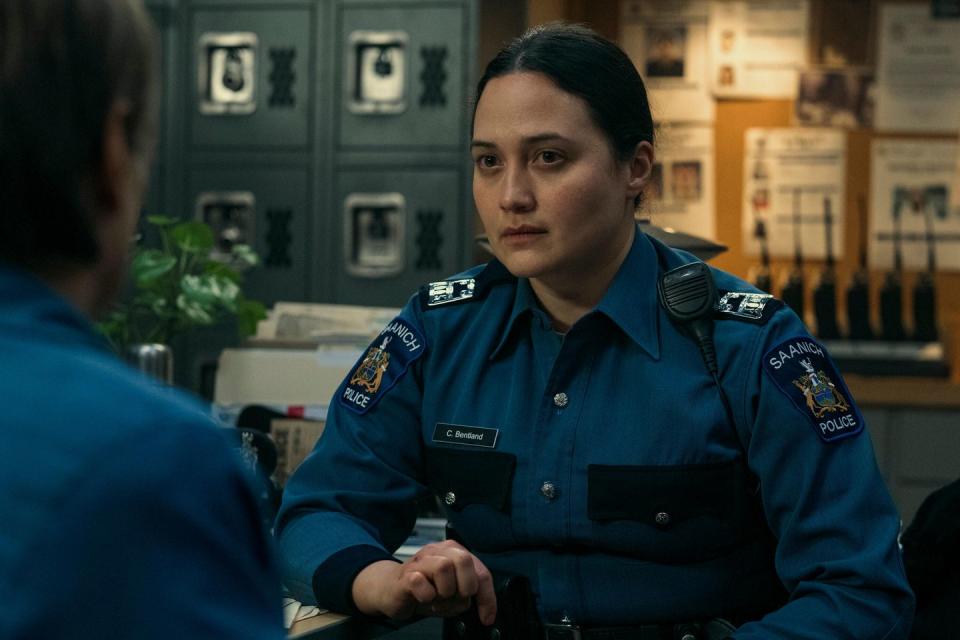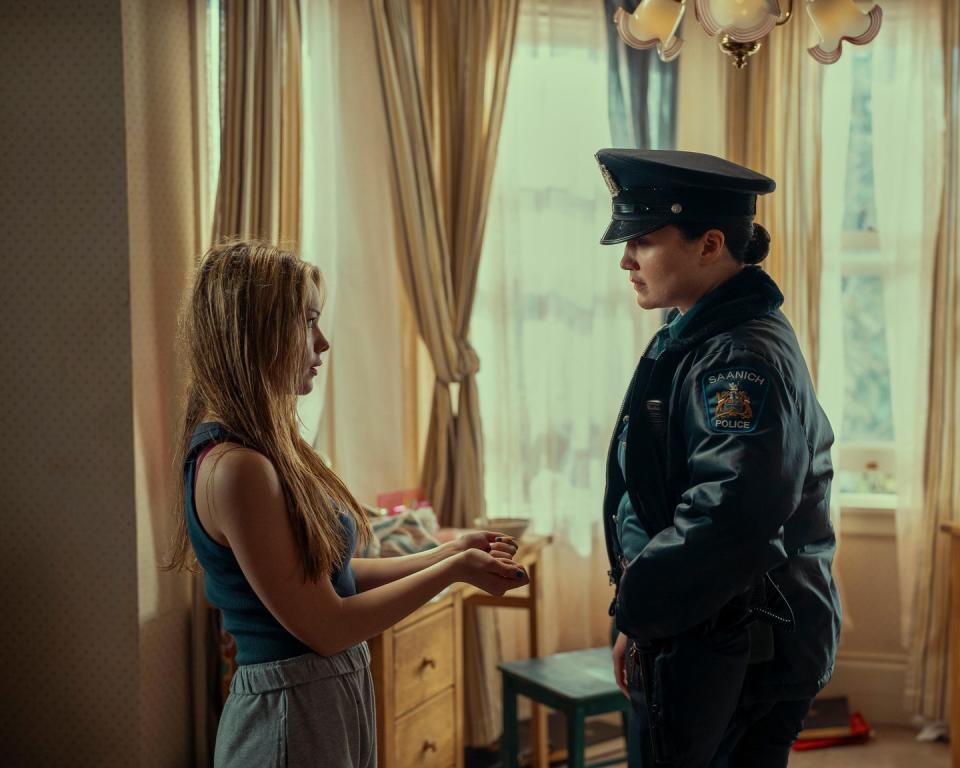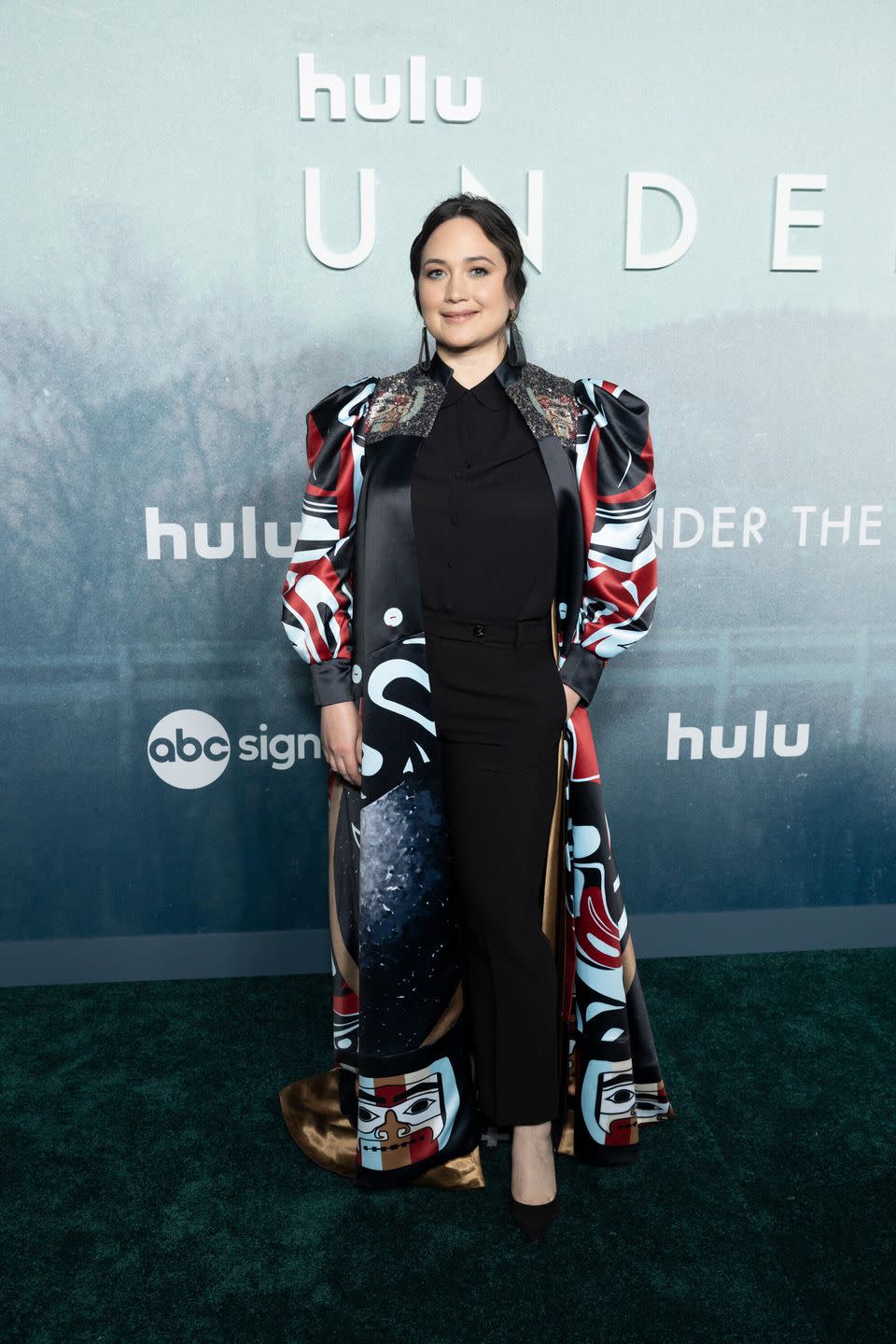Lily Gladstone Has More Stories to Tell

- Oops!Something went wrong.Please try again later.
- Oops!Something went wrong.Please try again later.
- Oops!Something went wrong.Please try again later.
"Hearst Magazines and Yahoo may earn commission or revenue on some items through these links."
Lily Gladstone wasn’t planning to tell another true-crime story so soon. Having just wrapped production on Martin Scorsese’s Killers of the Flower Moon—in which she starred as an oil-rich Osage woman who faces the ultimate betrayal from her white husband conspiring to kill her loved ones in an attempt to gain control of her family fortune—Gladstone was wary of the emotional toll that came with recreating and reliving the worst years of someone’s life.
But when she received an offer to star opposite Riley Keough in the new Hulu limited series Under the Bridge, Gladstone felt that there was an opportunity to reexamine the systemic issues that precipitated the brutal 1997 murder of Reena Virk, a 14-year-old Indo-Canadian girl who was the victim of bullying and ostracization, at the hands of her own peers near Victoria, British Columbia.
“I was like, even though it’s in the true-crime genre, this is a story that really matters,” Gladstone tells Harper’s Bazaar on a recent call from New York City. “It took [on] a self-indicting nature the same way that I felt Killers of the Flower Moon did to have really important conversations about societal shifts we can make in a way that only a true story can … because it actually happened.”
Based on the late Rebecca Godfrey’s narrative nonfiction book of the same name and adapted by Quinn Shephard, the eight-part series reexamines the events leading up to the night of Virk’s death and the subsequent trial that incited a moral panic in Canada and led to the conviction of multiple teens.
Keough plays a version of Godfrey, while Gladstone plays Cam Bentland, an Indigenous police officer adopted into a white, all-male family of cops who finds herself reckoning with her own identity during the gripping investigation. “There was a female officer on the force at the time, but Cam was a creation to have certain conversations that needed to be had in the show,” Gladstone says.
In the show, Godfrey and Bertland are connected by the loss of the former’s brother, Gabe; in real life, when she was a teenager, Godfrey lost her brother, Jonathan. “While they’re investigating a crime committed by and against a group of adolescent girls and one boy, both characters can have a particular recall, especially because the tension and trauma in their relationship all stems from their teenage years together,” Gladstone explains. “Suddenly, you’re thrust back together with a person that was huge in your formative years, and it takes you back there pretty immediately.”
Below, Gladstone—who won a Golden Globe and a SAG Award and became the first Native American to be nominated for the Academy Award for Best Actress for her work in Killers—opens up about her return to the true-crime genre, and how she navigates the weight and responsibility that comes with being among the first to break the glass ceiling for Native actors.
What kinds of conversations did you have with creator Quinn Shephard and showrunner Samir Mehta about this retelling of Reena Virk’s story?
I saw a quick breakdown of who the character of Cam was. An Indigenous cop is all it said in the description of her character, so I was a little curious there. I feel like a lot of times, especially right now, even though every single Indigenous actress who plays a cop on TV does so in a very different nuanced way and everybody’s super talented, I was a little reluctant to join that roster.
But I had a list of questions when I sat down with Quinn and Samir. Knowing that Riley was attached, not just to act in it, but also to co-produce it, and just being a fan of her acting and her advocacy and the things that she really cares about, it told me that there was probably something a little bit special about this series that I should at least take a meeting about. Knowing that it took place in Canada, I had a short list of things about Cam that I’d written down—just my knowledge of this epidemic, this widespread government-pushed initiative in Canada that’s now known by survivors as the “Sixties Scoop.” I was wondering if that was going to tie into Cam’s storyline at all, especially knowing that she was an adoptee.
I learned in this first meeting that Quinn and Samir had optioned [Reena’s father] Manjit Virk’s memoir, which really dove into the way that the family was treated, the media sensationalism, and law enforcement’s early dismissal of Reena’s disappearance. What the Virks had gone through with law enforcement prior to what happened to Reena was incredibly traumatic—and Manjit was absolutely profiled. [Editor’s note: In 1996, Reena falsely accused her father of sexual abuse in hopes of being moved to a foster home and given more freedom. The charges were later dropped, and Manjit’s record was expunged.] And then when his daughter disappeared, everybody was so quick to dismiss race as a factor when it very clearly was part of why Rena was marginalized and vulnerable to bullying.
There was a lot that drew me to this series, and ultimately, what really piqued my interest is when Quinn not only mentioned the “Sixties Scoop,” but also restorative justice, which is a movement led by Indigenous Canadians to address these inequities in the judicial system and all the incarcerated Indigenous folks there are. It’s an alternative to a punitive system, [which] makes people worse than before they go in, and it really plays out beautifully in the story of Reena Virk, particularly led by her family and the level of radical forgiveness they were able to have.

What were the most important considerations that you had in mind when it came to building and understanding Cam as a person?
The arc that she has was a compelling one to me because it’s a point A to point B arc, but in a lot of ways, it’s a very holistic return to herself. I think Cam’s origins, which she learned through the course of the show, is what gives her a particular empathy and a particular instinct about Reena’s case. Having spent some time in Seven Oaks, the group home where all the girls [involved in the murder] are from, Cam had unique insight in that regard. I feel like it’s particularly what gave her an empathy not just for Reena, but for Dusty [a young Black girl implicated in Reena’s death, played by Aiyana Goodfellow]. I love the relationship that Dusty and Cam have and what it represents.
Cam becomes a cop because it’s a legacy within her family. There are a number of small-town cops that I know personally. [Being a cop] wears itself differently in a small town where jobs are limited anyway, or sometimes it is this legacy that people take up. It’s always kind of puzzled me how many people in law enforcement listened to anti-establishment punk music. [Laughs.] I figured that was kind of the foundation of Cam and Rebecca’s friendship as teenagers.
I think there’s a real nobility in the career path Cam has chosen, and she gets a little bit disenchanted with it as this case unfolds and she sees what’s happening. I like that Cam ultimately embodies whatever that spirit is to serve and protect. In the beginning, she’s starting out wanting career advancement, but then deciding, “Maybe that’s not the most noble thing to do if what I want to do with this job is to serve and protect. Maybe there’s other ways that I can do that.”
One thing that I’ve admired about your body of work is your unwavering commitment to carving out your own space in the business and using your platform to advocate for other Native talent. You’ve spoken openly about this metaphor of holding the door open for others to come after you. How have you approached that delicate balance between making choices that advance your own career and knowing when to branch out and include as many people in the conversation as possible?
I feel like the two are so intertwined because “me is we.” I was created by community, so I feel like getting thrust into an international spotlight with such names as Scorsese, [Leonardo] DiCaprio and [Robert] De Niro, it’s a pretty quick, steep trajectory to be on. I’m lucky that I have a community to uplift and to take along with me. I think this much attention falling on any one person can be really ungrounding and scary, and I don’t know that I would’ve done as well with it if I didn’t also feel that it was happening with a lot of other people. At the same time, I was so happy that I could point to the performance of Kali Reis in True Detective, or to Alaqua Cox’s representation and wonderful performance in Echo, and just talk about this moment that we’re all having together.
For me, just the transparent fact that I get to act and do this for a living is enough personal gratification and individual fulfillment. That’s all I need. I’m seeing shows pitched to me now with Native showrunners that don’t necessarily have to do with life on the [reservation]. And if it does, then [it’s done] with these really beautiful treatments that show what it’s actually like and show how much humor there is. I’m standing on the shoulders of so many Native talents and loving the work that they do, and they really humanized a lot of the industry [and] paved the way for the rest of us. It’s exciting to be stepping into a time where that box has expanded. If we are pigeonholed into a box, being Native talent, that box is way bigger and more inclusive now.

Now that you have relatively more power to dictate the kinds of shows and movies you want to make, are there specific stories—centered on the Native American experience or otherwise—that you find yourself wanting to tell?
There’s a lot of figures in history that are Native that had a really broad cultural impact; our communities raised some really incredible, prolific people. There’s some pretty big names in music that people don’t realize were Native who were so foundational, who have gotten completely erased from history. There’s a ton of Indigenous movers and shakers and people who have made history that have affected everybody that are unknown [in pop culture]. So in that sense, whether acting in or elevating or producing, [I want to be] plugging all of these biopics because that’s a fun genre to dive into as an actor.
I’m also really thrilled that I’m getting pitched good, solid, fun action films that don’t necessarily have anything to do with an identity—but just a story. I’ve got a wonderful romantic comedy, an ensemble comedy, coming up. It’s going to be my next feature film. That one’s not announced yet. There’s a place that’s carved out for us, but I think people or the industry have relaxed some of that tendency to pigeonhole, and they see performers for who we are and the tone that we can each bring individually. Any space that I feel like [myself] or any other Indigenous performer occupies onscreen just goes further toward representation.

On that note, you’ve described your next film, Fancy Dance, as “a love letter to Indigenous women and the love we carry for our people.”
Fancy Dance has a nice little direct tie to Under the Bridge. The actress [Isabel Deroy-Olson] who played young Cam in Under the Bridge also plays my niece in Fancy Dance. That was another reason I was excited to take [Under the Bridge] because I knew it was filming in Vancouver, and I knew I could go spend time with my new niece after we wrapped Fancy Dance. That one’s a really beautiful indie that, if you were to put it on your shelf next to other films in your collection, it would go between Paper Moon and Thelma & Louise.
Audiences do tend to come for it because they know it’s a Native American story, and people expect to see a certain thing when that happens. It was a really exciting opportunity for me to get to play a full character that has flaws. I think a lot of times when we do get feature films that garner a lot of attention—it doesn’t just happen in Natives—there’s this unfortunate, I don’t know if it’s a trope or a phenomenon, this model minority thing. We deserve to have stories where we’re not model minorities—where we’re people who are making the best of what we have, who are doing some not so great things to keep themselves afloat. [My character] Jax is definitely imperfect, but she’s absolutely a product of her environment and she does whatever it takes to keep her family going, especially in a world that’s not designed for her [to succeed].
It has a very deep, important and timely message about the reality of missing, murdered Indigenous relatives, about keeping our families together and not encouraging this pipeline of children being taken out of our communities. There’s a lot of very big issues that our film addresses, but I hope audiences can approach it as if they’re going to watch Thelma & Louise.
This interview has been edited and condensed for length and clarity.
Under the Bridge is now streaming on Hulu, with a new episode airing every Wednesday through May 29. Fancy Dance premieres June 21 in select theaters and June 28 on Apple TV+.
You Might Also Like

